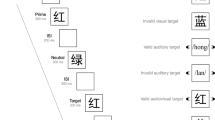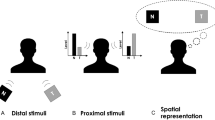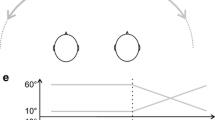Abstract
Using a cue–target paradigm, this study investigated the interaction between location and frequency information processing in human auditory inhibition of return (IOR). The cue and the target varied in terms of location and frequency and participants were asked to perform a target detection, localization or frequency discrimination task. Results showed that, when neither location nor frequency of auditory stimuli was particularly relevant to the target detection task, there was a location-based IOR only if the cue and the target were identical in frequency and there was a frequency-based IOR only if the cue and the target were presented at the same location. When a particular feature of auditory stimuli, whether location or frequency, was directly relevant to the current task, the IOR effect was evident for this feature only if the cue and the target differed on the task-irrelevant feature, while the IOR effect was eliminated for the task-relevant feature when the cue and the target had the same task-irrelevant feature. Similarly, the IOR effect based on the task-irrelevant feature was evident when the cue and the target differed on the task-relevant feature, and was eliminated or reversed when the cue and the target shared the task-relevant feature. Theoretical implications of these findings for auditory IOR are discussed.



Similar content being viewed by others
References
Abrams RA, Dobkin RS (1994) Inhibition of return: Effects of attentional cuing on eye movement latencies. J Exp Psychol Hum Percept Perform 20:467–477
Chen Q, Zhang M, Zhou X (2006) Spatial and nonspatial peripheral auditory processing in congenitally blind people. Neuroreport (in press)
De Jong R, Liang C-C, Lauber E (1994) Conditional and unconditional automaticity: a dual-process model of effects of spatial stimulus-response correspondence. J Exp Psychol Hum Percept Perform 20:731–750
Forster KI, Forster JC (2003) DMDX: a Windows display program with millisecond accuracy. Behav Res Methods Instrum Comput 35:116–124
Francis L, Milliken B (2003) Inhibition of return for the length of a line? Percept Psychophys 65:1208–1221
Fuentes LJ, Vivas AB, Humphreys GW (1999) Inhibitory tagging of stimulus properties in inhibition of return: effects on semantic priming and flanker interference. Q J Exp Psychol A 52:149–164
Handy TC, Jha AP, Magnun GR (1999) Promoting novelty in vision: inhibition of return modulates perceptual-level processing. Psychol Sci 10:157–161
Harvey N (1980) Non-informative effects of stimuli functioning as cues. Q J Exp Psychol 32:413–425
Hunt AT, Kingstone A (2003) Inhibition of return: dissociating attentional and oculomotor components. J Exp Psychol Hum Percept Perform 29:1068–1074
Ivanoff J, Klein RM (2001) The presence of a nonresponding effector increases inhibition of return. Psychon Bull Rev 8:307–314
Kahneman D, Treisman A, Gibbs S (1992) The reviewing of object files: object specific integration of information. Cogn Psychol 24:175–219
Khatoon S, Briand KA, Sereno AB (2002) The role of response in spatial attention: direct versus indirect stimulus-response mappings. Vis Res 42:2639–2708
Kingstone A, Pratt J (1999) Inhibition of return is composed of attentional and oculomotor processes. Percept Psychophys 61:1046–1054
Klein RM (2000) Inhibition of return. Trends Cogn Sci 4:138–147
Kwak H, Egeth H (1992) Consequences of allocating attention to locations and to other attributes. Percept Psychophys 57:455–464
Law MB, Pratt J, Abrams RA (1995) Color-based inhibition of return. Percept Psychophys 57:402–408
Lupianez J, Decaix C, Sieroff E, Chokron S, Milliken B, Bartolomeo P (2004) Independent effects of endogenous and exogenous spatial cueing: inhibition of return at endogenously attended target locations. Exp Brain Res 159:447–457
Lupiáńez J, Milan EG, Tornay F, Madrid E, Tudela P (1997) Does IOR occur in discrimination tasks? Yes, it does, but later. Percept Psychophys 59:1241–1254
Lupiáńez J, Milliken B (1999) Inhibition of return and the attentional set for integrating versus differentiating information. J Gen Psychol 126:392–418
Lupiáńez J, Milliken B, Solano C, Weaver B, Tipper SP (2001a) On the strategic modulation of the time course of facilitation and inhibition of return. Q J Exp Psychol 54A:753–773
Lupiáńez J, Weaver B, Tipper SP, Madrid E (2001b) The effects of practice on cueing in detection and discrimination task. Psicologica 22:1–23
Maylor EA (1985) Facilitatory and inhibitory components of orienting in visual space. In: Posner MI, Marin OSM (ed) Attention and performance, vol XI. Erlbaum, Hillsdale, pp 189–204
Maylor EA, Hockey R (1985) Inhibitory component of externally controlled covert orienting in visual space. J Exp Psychol Hum Percept Perform 11:777–787
McDonald JJ, Ward LM (1999) Spatial relevance determines facilitatory and inhibitory effects of auditory covert spatial orienting. J Exp Psychol Hum Percept Perform 25:1234–1252
Melara RD, Marks LE (1990) Perceptual primacy of dimensions: support for a model of dimensional interaction. J Exp Psychol Hum Percept Perform 16:398–414
Miller J (1988) Discrete and continuous models of human information processing: theoretical distinctions and empirical results. Acta Psychol 67:191–257
Milliken B, Tipper SP, Houghton G, Lupiáńez J (2000) Attending, ignoring, and repetition: on the relation between negative priming and inhibition of return. Percept Psychophys 62:1280–1296
Mondor TA (1999) Predictability of the cue–target relation and the time-course of auditory inhibition of return. Percept Psychophys 61:1501–1509
Mondor TA, Breau LM (1999) Facilitative and inhibitory effects of location and frequency cues: evidence of a modulation in perceptual sensitivity. Percept Psychophys 61:438–444
Mondor TA, Breau LM, Milliken B (1998a) Inhibitory processes in auditory selective attention: evidence of location-based and frequency-based inhibition of return. Percept Psychophys 60:296–302
Mondor TA, Lacey TE (2001) Facilitative and inhibitory effects of cuing sound duration, intensity, and timbre. Percept Psychophys 63:726–736
Mondor TA, Zatorre RJ, Terrio NA (1998b) Constraints on the selection of auditory information. J Exp Psychol Hum Percept Perform 24:66–79
Posner MI, Cohen Y (1984) Components of visual orienting. In: Bouma H, Bouwhuis DG (eds) Attention and performance, vol X. Erlbaum, Hillsdale, pp 531–556
Pratt J (1995) Inhibition of return in a discrimination task. Psychon Bull Rev 2:117–120
Pratt J, Abrams RA (1999) Inhibition of return in discrimination tasks. J Exp Psychol Hum Percept Perform 24:229–242
Pratt J, Castel AD (2001) Responding to feature or location: a re-examination of inhibition of return and facilitation of return. Vis Res 41:3903–3908
Pratt J, Kingstrone A, Khoe W (1997) Inhibition of return in location- and identity-based choice decision tasks. Percept Psychophys 59:964–971
Prime DJ, Ward LM (2002) Auditory frequency-based inhibition differs from spatial IOR. Percept Psychophys 64:771–784
Rafal RD, Henik A (1994) The neurology of inhibition. Integrating controlled and automatic processes. In: Dagenbach D, Carr T (eds) Inhibitory Processes in attention, memory and language. Academic, San Diego, pp 1–50
Rafal RD, Calabresi PA, Brennen CW, Sciolto TK (1989) Saccade preparation inhibits reorienting to recently attended locations. J Exp Psychol Hum Percept Perform 15:673–685
Reuter-Lorenz PA, Jha A, Rosenquist JN (1996) What is inhibited in inhibition of return? J Exp Psychol Hum Percept Perform 22:367–378
Reuter-Lorenz PA, Rosenquist JN (1996) Auditory cues and inhibition of return: the importance of oculomotor activation. Exp Brain Res 112:119–126
Riggio L, Patteri I, Umilta C (2004) Location and shape in inhibition of return. Psychol Res 68:41–54
Sanders AF (1990) Issues and trends in the debate on discrete vs. continuous processing of information. Acta Psychol 74:123–167
Schmidt WC (1996) “Inhibition of return” without visual input. Neuropsychologia 34:943–952
Spence CJ, Driver J (1997) Audiovisual links in exogenous covert spatial orienting. Percept Psychophys 59:1–22
Spence CJ, Driver J (1998a) Auditory and audiovisual inhibition of return. Percept Psychophys 60:125–139
Spence CJ, Driver J (1998b) Cross-modal links in exogenous covert spatial orienting between touch, audition, and vision. Percept Psychophys 60:544–557
Spence CJ, Lloyd D, McGlone F, Nicholls MER, Driver J (2000) Inhibition of return is supramodal: a demonstration between all possible pairing of vision, touch and audition. Exp Brian Res 134:42–48
Sternberg S (1969) The discovery of processing stages: extensions of Donder’s method. Acta Psychol 30:276–315
Tanaka Y, Shimojo S (1996) Location vs. feature: reaction time reveals dissociation between two visual functions. Vis Res 36:2125–2140
Tassinari G, Aglioti S, Chelazzi L, Marzi CA, Berlucchi C (1987) Distribution in the visual field of the costs of voluntarily allocated attention and of the inhibitory after-effects of covert orienting. Neuropsychologia 25:55–71
Tassinari G, Campara D, Benedetti C, Berlucchi C (2002) The contribution of general and specific motor inhibitory sets to the so-called auditory inhibition of return. Exp Brain Res 146:523–530
Taylor TL, Klein RM (1998) On the causes and effects of inhibition of return. Psychon Bull Rev 5:625–643
Taylor TL, Klein RM (2000) Visual and motor effects in inhibition of return. J Exp Psychol Hum Percept Perform 26:1639–1656
Tipper SP, Weaver B, Jerreat LM, Burak AL (1994) Object-based and environment-based inhibition of return of visual attention. J Exp Psychol Hum Percept Perform 20:478–499
Vivas AB, Fuentes LJ (2001) Stroop interference is affected in inhibition of return. Psychon Bull Rev 8:315–323
Acknowledgments
The research reported here was supported by National Pandeng Project (95-special-09) and by grants from the China National Science Foundation (30070260, 30470569, 60435010) and the Ministry of Education of China (2002/53, 01002, 02170). We thank Dr. Juan Lupiáńez and two anonymous reviewers for their comments on early versions of this paper.
Author information
Authors and Affiliations
Corresponding author
Rights and permissions
About this article
Cite this article
Chen, Q., Zhang, M. & Zhou, X. Interaction between location- and frequency-based inhibition of return in human auditory system. Exp Brain Res 176, 630–640 (2007). https://doi.org/10.1007/s00221-006-0642-0
Received:
Accepted:
Published:
Issue Date:
DOI: https://doi.org/10.1007/s00221-006-0642-0




